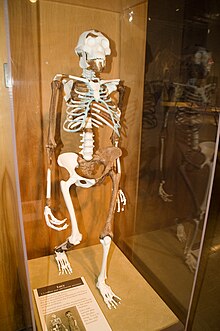Australopithecus afarensis


Australopithecus afarensis (from the Latin 'Afar southern monkey') is an extinct hominid of the subtribe Hominina that lived between 3.9 and 3 millions of years ago. It had a thin and graceful build, and it is believed that it lived only in East Africa (Ethiopia, Tanzania and Kenya). Most of the scientific community accepted that it may be one of the ancestors of the genus Homo.[citation needed]
Discovery
It was discovered in 1974 by Donald Johanson, Yves Coppens and Tim White at the Hadar site, Awash River Valley, Ethiopia. The specimen found at that time was known worldwide as Lucy.
This discovery stood out especially for being the best preserved Australopithecus discovered to that date. Thus it was possible to verify that the ability to walk upright, like current humans, was long before brain growth. The study of their teeth clarified fundamental aspects about the evolution of hominids and discovered the simultaneous evolution of genera, so that the Paranthropus line diverged from others and in particular from the one that evolved towards Homo.[citation needed]
Lucy's remains were found in the place where the Afar tribe lived, hence the name afarensis, and together with twelve other individuals of the same species, including skulls, they make up what is called "the first family".
In recent years, many fossil remains older than those of Lucy have been discovered, which is why she was no longer considered the 'grandmother of humanity', although the discovery did not lose its importance. Today, Lucy's remains are kept in a safe in Addis Ababa, the capital of Ethiopia.
In several excavation campaigns, between 2000 and 2005, the remains of a girl Australopithecus afarensis, 3 years old and 3.3 million years old, were found from the site of Dikika, near the Awash River in Raft Valley. The girl is known as Selam.
Physical characteristics
Australopithecus afarensis is, like all Australopithecus, an upright bipedal primate, but different from humans in several aspects:
- Cranial capacity between 380 and 450 cm3, which would correspond to the size of the brain of a chimpanzee and close to the third part of the current average human.
- His chest had no barrel shape, as in humans, but narrowed upwards (bell form).
- Sexual dimorphism was very marked, with males being much more corpulent than females, with an average body mass of 45 kg for males and 29 kg for females.
Bone morphology
As has been said, the skull was relatively small, with a volume similar to that of current anthropomorphs, although compared to the size of the body it was relatively large. Furthermore, his face was quite large and projected in front of the skull, due to the size of the teeth (prognathism).
The skull has small sagittal and nuchal crests, comparable to those of the current male gorilla, but much smaller.
Unlike anthropomorphs, the canines of Australopithecus afarensis are reduced although they project slightly in front of the adjacent tooth. The incisors are large (associated with the frugivorous regime). The molars and premolars are of substantial size, with flat surfaces.
From his mouth it is also concluded that the palate is very similar to that of modern man because although it is large, it forms a curve that is not parabolic, nor with parallel sides, as in the great apes.
The shape of the pelvis is important, since necessary studies have been carried out on it to determine the upright bipedal walk of Australopithecus; It is small in size compared to anthropomorphs and has a birth canal, in the female, smaller than the current one and with a noticeable kidney shape. Females of the species did not need to have a large birth canal, due to the small size of the skull of the offspring.
The phalanges of the fingers are curved, both those of the hands and those of the feet (more markedly in the latter). This characteristic suggests that they had a great ability to climb and hang from the branches of trees, so it is thought that these were their more or less usual means.
Use of tools
The first tools used by a human ancestor date back to about 2.5-2.6 million years ago, their manufacture being attributed to Homo habilis. However, an investigation carried out by an international and multidisciplinary team of researchers concluded that Australopithecus afarensis used sharp stones to extract the meat from the bones and obtain the marrow from them.
If this thesis is confirmed, it would provide important novelties in research on the origins of the human being, since it would imply the consumption of meat, related to the size of the brain, advancing this, and associated with the use of tools, 800,000 years sooner than expected.
However, this position has many detractors. Manuel Domínguez-Rodrigo, a Spanish archaeologist, maintains that the bones were trampled by animals. Tim D. White of the University of California claims to have worked in the area for 40 years and not to have found a single stone tool. Sileshi Semaw of Indiana University believes researchers sometimes confuse marks on bones with animal trampling or other natural causes.
Important fossils
- Lucy.
- Laetoli
- AL 200-1
- AL 129-1
- Selam, a 3.3 million-year-old girl.
Praeanthropus
Some authors place Australopithecus afarensis and Australopithecus anamensis in a separate genus called Praeanthropus.
Contenido relacionado
Diogenes
Uku Pacha
Creation myth
Tartessian language
Basque Country